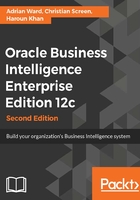
Terminology differences from Oracle BI 11g
There are a few noticeable changes in architecture terminology when comparing Oracle BI 11g to Oracle BI 12c. Let's call out a few of these key differences, as they are relevant to the language used throughout the book.
The first is that Fusion Middleware Home, as it relates to the installation of Oracle BI and the location of files in the file system, is now called ORACLE HOME. In Oracle BI 11g, Fusion Middleware Home was the base install folder for your Oracle BI 11g installation. The same concept is used in Oracle BI 12c; it is now rather more appropriately called the ORACLE HOME. This makes sense as traditionally, in an n-tier server architecture, the Oracle BI system is installed on its own application server. Therefore, it would be the only core Oracle technology application on a machine, not conflicting with any other Oracle home install locations from other applications.
The second is that the Oracle Process Management and Notification Server (OPMN) is no longer used to manage the Oracle BI System Components. This has been replaced by a more integrated process, which still allows start, stop, and status of Oracle BI to be controlled by the command line or through Enterprise Manager. These components, previously managed by the OPMN, are still referred to as the BI System Components (that is, BI Server, BI Presentation Server, and so on). This also means that the idea of instances is now replaced by Service Instances.